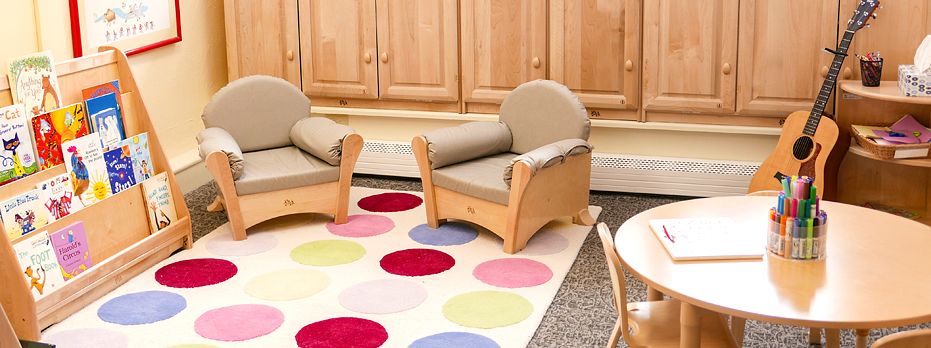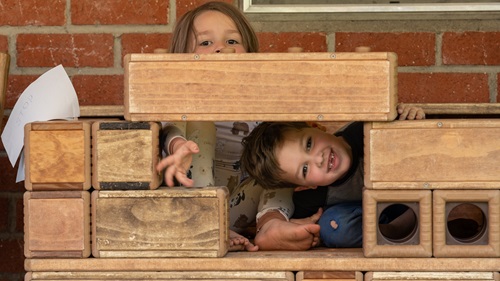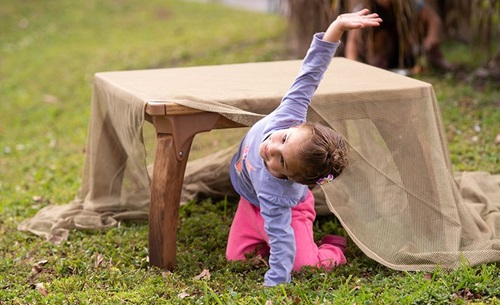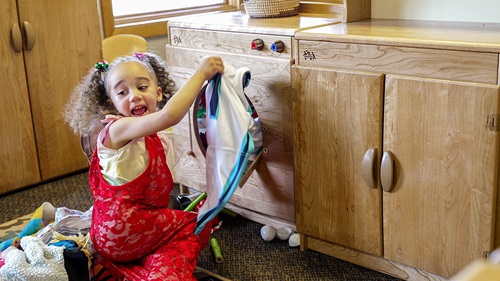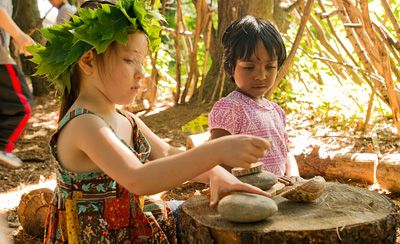Transforming Spaces: Rethinking the Possibilities
| September 2006From the location of learning areas to the selection and presentation of learning materials, the design of the physical environment powerfully impacts all aspects of an early childhood program. You know when you are in a well-designed environment – you don’t want to leave. Purposeful, engaging, and beautiful environments blend and balance the best elements of home, school, and community life together. When you enter the space, you feel like a special guest. The environment is warm and inviting. There are endless possibilities for inventing and creating. Here, lasting friendships are made. At the end of the day, you don’t feel depleted; instead, you feel excited about what the next day will bring.
Whether you’re thinking about adding more private cozy areas, reducing the amount of furniture you have, or changing color schemes in your current space, transforming tired spaces into wonderful places is not an easy job. As former teachers, now design consultants, we help programs rethink the possibilities for how they can transform their existing spaces into more interesting, functional, and beautiful places where all learners can thrive. Since the majority of programs we work with reside in secondhand spaces, like church basements, retired schools, remodeled houses, and storefronts, we know firsthand from our own experiences how challenging these environments can be to work in.
In this article, we hope to share with you some success stories and design ideas that have worked for other programs. One word of caution: no two environments are alike. Every physical space has its unique challenges, qualities, and quirks. No one set of guidelines or standard room design works for everyone. So much depends on the philosophy of the program, size of the space, number of fixed features, and the hopes and dreams of the team. We challenge programs to design their own environmental checklist as a way of seeing their spaces in new ways. We also encourage programs to draw from many different sources, and to look to those places that have inspired them the most. Here are some stories and ideas that have inspired us.
Start from the end and work forward
Being able to visualize and clearly articulate what you want and how you plan to get there is important no matter where you are in the process. Use drawings, pictures from magazines, and photographs of other places to describe what you want your environment to look and feel like.
Questions to pose:
- What elements in your current environment (i.e., home, office, school, favorite places to shop) do you find appealing? Why?
- What are some of your most cherished memories from childhood? Why are they so special?
- If you could design the most ideal environment for children and adults, what would it look like?
Display these images in places where everyone can see them. Vision making needs to be fluid and continuous. Don’t rush the process.
Do your research
Identify what is currently working well in your space, as well as what is problematic. Observe and record (i.e., photographs, notes, or videotape) how children and adults use and experience the space from the moment they arrive until the moment they leave.
Questions to pose:
- Where do children and adults prefer to spend their time?
- What messages do each of these areas communicate?
- How does the space design promote or hinder optimal development?
From your data, prioritize the areas in your environment that need the most attention. After careful observation, one program realized how congested their entrance area always was. Instead of inviting conversation, promoting self-help skills, and providing a relaxed transition into the day, children and parents felt rushed and hurried. By enlarging the area, and adding a full-length mirror and a small bench, this area became a place where children could move with comfort and ease into the other areas.The area also became another cozy spot where children could be alone.
Who’s on your design team?
Everyone – including children, parents, and staff – contributes to the design process. From bargain shopping, to collecting loose parts, to sewing and gardening, we all have a special interest or skill to share.
Questions to pose:
- Who on the team can oversee the design process and coordinate the projects?
- Do you have a list of current persons, places, or businesses that can help with materials and skills?
- What working partnerships do you have in place with other organizations that are interested in promoting design work for children (i.e., children’s museums, universities, senior programs)?
- How do you acknowledge the contributions of others?
At the Progress Center in Longview, Washington (a program serving infants and toddlers with special needs), Bob, a retired senior in the community – enjoys spending his free time designing and building equipment for the program. To honor Bob, the director had baseball caps made with his name imprinted on them. On special occasions, everyone wears their BOB CAPS.
Clean out and de-clutter before you start
It’s hard to imagine what is possible when you are surrounded by unnecessary clutter. Most programs we visit suffer from clutter overload. While good at collecting stuff, centers readily admit how hard it is to get rid of things. Before adding new equipment or materials to your program, consider the following questions.
Questions to pose:
- How much is enough?
- Do you have a current inventory list?
- Do you have a balance of learning materials from found, collected, home-made to commercial?
- What condition is your storage in?
- Does your plan for caring for the environment include everyone?
One program decided it was time to call a halt to purchasing any additional materials until they had conducted a complete inventory. In the process, they discovered they had more than they needed, and too much of the same kinds of materials. They also began exploring new ways to store, display, and present the materials in an attractive and functional manner. For a start, they added storage shelves under their water/sand tables and rain gutters to their walls to display books and puzzles.
Maximizing space
Ask teachers what they want more in their environment, and they will tell you…more space. Because most of the programs we work with meet only the minimum requirements for square footage, not the desired, the spaces often feel stressed by too much furniture and too many learning centers crowded into one space. In addition, the number of fixed features (i.e., number of doors, windows, location of electrical outlets) plays a major role in determining the size, location, and what types of learning materials can be offered in each area.
We encourage design teams to reexamine what they have been told about room arrangements. How many times have you heard “We must have a science center” or “We can only purchase child-size furnishings”? We often see too many vacant science centers or child-size furnishings taking up valuable space or being used inappropriately. We encourage programs to reframe their questions from “Can we?” to “How many different ways can we?” and to experiment with a variety of different floor plans, first on paper before committing to a plan. A well-designed environment must be flexible and responsive to the varying needs, interests, and passions of the people who live there or else it won’t work.
Questions to pose:
- What are all the wonderful experiences you want to offer children?
- What learning areas/centers can be combined to make more space? (Can writing, computer, and library be combined? How many ways can science be offered throughout the classroom?)
- What different ways can learning areas be defined (I.e., level changes from hanging fabric to low platforms, fish tanks, plants, or arranging the furniture at different angles.)
- What are the different ways parents and children can be involved in the design process from designing to constructing materials and furniture?
One program decided to enlarge the home center and move it to the middle of the classroom. Over time, they built a wooden enclosure with windows and low shelves inside for sorting and stacking materials. On the outside, they added mirrors at different heights and hooks for the dress-up clothes.This area became the hub where children gathered, and a focal point for children’s works and projects.
Another program opted for a variety of different sitting arrangements from benches to stools to chairs of different heights. With additional options, they provided interesting motor challenges for the children and the space felt more homelike.
Another program put wheels on all their furniture so they could dance at the end of the day. They also adapted their water and sand tables with different types of lids (i.e., peek-a-boo, clear Plexiglas) and used the tables for both sensory play and mealtimes.
Beautiful Places
All children, regardless of abilities or backgrounds, deserve beautiful environments. Designing aesthetically pleasing environments, in our opinion, is not an option but a necessity. If we want children to grow up to have an appreciation for the arts and aesthetics, then we must live what we believe. Besides, environments that lack beauty and comfort are stressful and tiring. Beautiful environments need not be costly or expensive. The most interesting and beautiful places we have visited are those that have been enriched and equipped with materials from home, nature, and from the children and adults themselves.
Questions to pose:
- How many different ways does your environment communicate comfort and beauty (i.e., soft areas, beautiful things to look at and touch?)
- How many different ways does your environment awaken one’s senses (i.e., pleasant smells, variety of different textures to touch and hold, variety of different sounds to hear and make)?
- What materials or areas currently detract from the beauty of your environment (i.e., too much plastic, overcrowded shelves, or open garbage cans)?
- Do you feel nourished when you are in your space?
One program decided after conducting a beauty inventory that the large garbage cans required for meals were a major eyesore. They enclosed the cans with wooden structures and had the children paint murals on the outside of the cans. Not only were they functional, they were also beautiful pieces of art to be admired.
As we mentioned earlier, transforming tired spaces into wonderful places is not an easy job. Learning how to turn design challenges into design opportunities takes time and persistence. It requires having an action plan and making tough choices about how resources (time, money, and materials) will be used. But as one teacher said so eloquently, what keeps her going is knowing what joy these places will bring, not only for the children who are here today but for the children who will come tomorrow.
Well-designed environments don’t just happen, they evolve over time.
Reprinted with Permission -- Child Care Information Exchange

